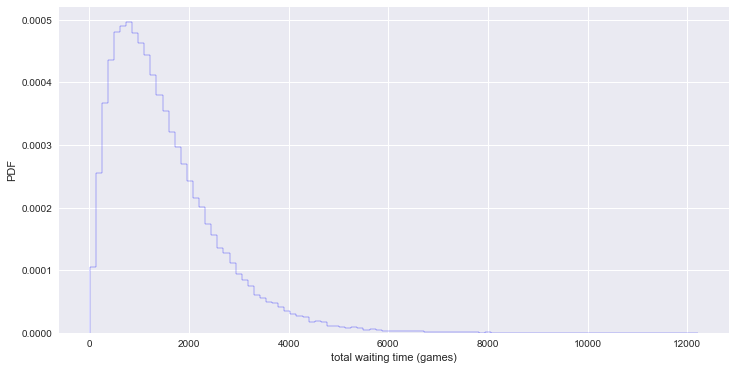통계적인 추론 with Seaborn 1
탐색적 분석, Bee swarm plot, 이항 분포, 지수 분포
import numpy as np
import pandas as pd
import seaborn as sb
# Set default Seaborn style
sb.set()
import matplotlib.pyplot as plt
%matplotlib inline
# setting plot defatult size
%pylab inline
pylab.rcParams['figure.figsize'] = (12, 6)
Populating the interactive namespace from numpy and matplotlib
1. Graphical exploratory data analysis
from sklearn.datasets import load_iris
iris = load_iris()
iris.feature_names
['sepal length (cm)',
'sepal width (cm)',
'petal length (cm)',
'petal width (cm)']
iris.target_names
array(['setosa', 'versicolor', 'virginica'],
dtype='<U10')
virginica_petal_length = iris.data[100:150,2]
virginica_petal_length
array([ 6. , 5.1, 5.9, 5.6, 5.8, 6.6, 4.5, 6.3, 5.8, 6.1, 5.1,
5.3, 5.5, 5. , 5.1, 5.3, 5.5, 6.7, 6.9, 5. , 5.7, 4.9,
6.7, 4.9, 5.7, 6. , 4.8, 4.9, 5.6, 5.8, 6.1, 6.4, 5.6,
5.1, 5.6, 6.1, 5.6, 5.5, 4.8, 5.4, 5.6, 5.1, 5.1, 5.9,
5.7, 5.2, 5. , 5.2, 5.4, 5.1])
Histogram
plt.hist(virginica_petal_length)
plt.ylabel('count')
plt.xlabel('petal length (cm)')
plt.title('virginica_petal_length')
plt.show()
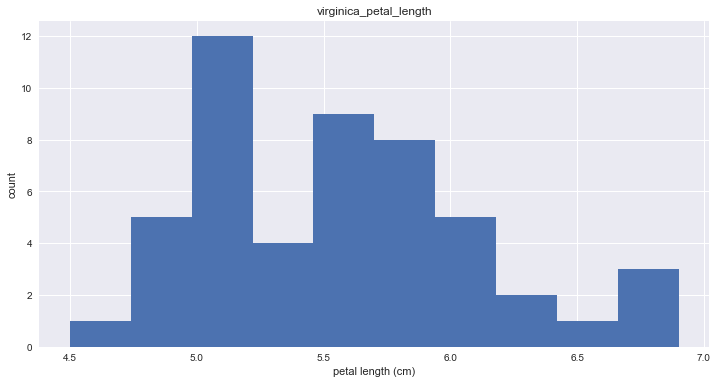
# Adjusting the number of bins
n_data = len(virginica_petal_length)
n_bins = int(np.sqrt(n_data))
n_bins
7
plt.hist(virginica_petal_length, bins=n_bins, edgecolor='black', facecolor='orange')
plt.ylabel('count')
plt.xlabel('petal length (cm)')
plt.title('virginica_petal_length')
<matplotlib.text.Text at 0x10f778f28>
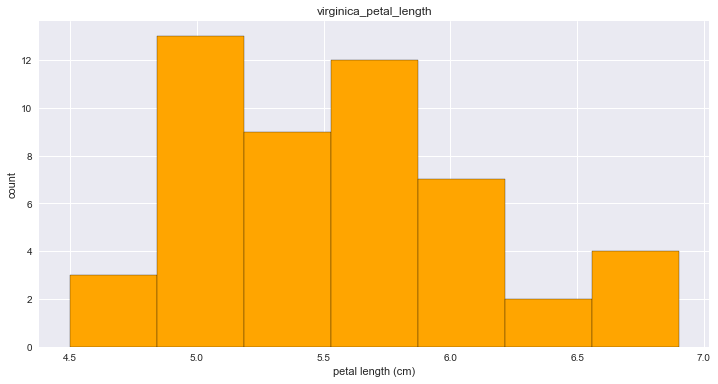
Transform iris dataset to pandas DataFrame
df_iris = pd.DataFrame(data = np.c_[iris['data'], iris['target']],
columns = iris['feature_names'] + ['target'])
df_iris.head()
| sepal length (cm) | sepal width (cm) | petal length (cm) | petal width (cm) | target | |
|---|---|---|---|---|---|
| 0 | 5.1 | 3.5 | 1.4 | 0.2 | 0.0 |
| 1 | 4.9 | 3.0 | 1.4 | 0.2 | 0.0 |
| 2 | 4.7 | 3.2 | 1.3 | 0.2 | 0.0 |
| 3 | 4.6 | 3.1 | 1.5 | 0.2 | 0.0 |
| 4 | 5.0 | 3.6 | 1.4 | 0.2 | 0.0 |
# 0:setosa, 1:versicolor, 2:virginica
df_iris.columns = ['sepal_length','sepal_width','petal_length','petal_width','target']
df_iris['target'] = df_iris['target'].astype('int')
df_iris.head()
| sepal_length | sepal_width | petal_length | petal_width | target | |
|---|---|---|---|---|---|
| 0 | 5.1 | 3.5 | 1.4 | 0.2 | 0 |
| 1 | 4.9 | 3.0 | 1.4 | 0.2 | 0 |
| 2 | 4.7 | 3.2 | 1.3 | 0.2 | 0 |
| 3 | 4.6 | 3.1 | 1.5 | 0.2 | 0 |
| 4 | 5.0 | 3.6 | 1.4 | 0.2 | 0 |
def make_species(x):
l_species = []
for i in x:
if (i == 0):
l_species.append('setosa')
elif (i == 1):
l_species.append('versicolor')
else:
l_species.append('virginica')
return l_species
df_iris['species'] = make_species(np.array(df_iris['target']))
df_iris.head()
| sepal_length | sepal_width | petal_length | petal_width | target | species | |
|---|---|---|---|---|---|---|
| 0 | 5.1 | 3.5 | 1.4 | 0.2 | 0 | setosa |
| 1 | 4.9 | 3.0 | 1.4 | 0.2 | 0 | setosa |
| 2 | 4.7 | 3.2 | 1.3 | 0.2 | 0 | setosa |
| 3 | 4.6 | 3.1 | 1.5 | 0.2 | 0 | setosa |
| 4 | 5.0 | 3.6 | 1.4 | 0.2 | 0 | setosa |
Bee swarm plots
_ = sb.swarmplot(x='species', y='petal_length', data=df_iris)
_ = plt.xlabel('species')
_ = plt.ylabel('petal length (cm)')
plt.show()
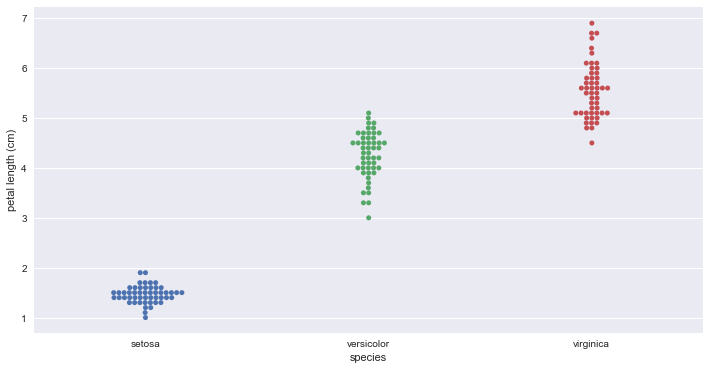
# 2012년 미국 대선 데이터
df = pd.read_csv('data/election2012.csv')
states = (df['state'] == 'CA') | (df['state'] == 'NY') | (df['state'] == 'OH') | (df['state'] == 'TX')
df2012 = df.loc[states]
df2012.head()
| state | county | Obama | Romney | winner | total | margin | turnout | |
|---|---|---|---|---|---|---|---|---|
| 157 | CA | Alameda | 78.5 | 18.7 | Obama | 542421 | 59.8 | 2.8 |
| 158 | CA | Alpine | 60.1 | 36.5 | Obama | 625 | 23.6 | 3.4 |
| 159 | CA | Amador | 39.2 | 58.2 | Romney | 14904 | 19.0 | 2.6 |
| 160 | CA | Butte | 46.4 | 50.3 | Romney | 67879 | 3.9 | 3.3 |
| 161 | CA | Calaveras | 40.1 | 57.1 | Romney | 17941 | 17.0 | 2.8 |
_ = sb.swarmplot(x='state', y='Obama', data=df2012)
_ = plt.xlabel('state')
_ = plt.ylabel('vote Obama %')
_ = plt.title('distribution of counties')
plt.show()
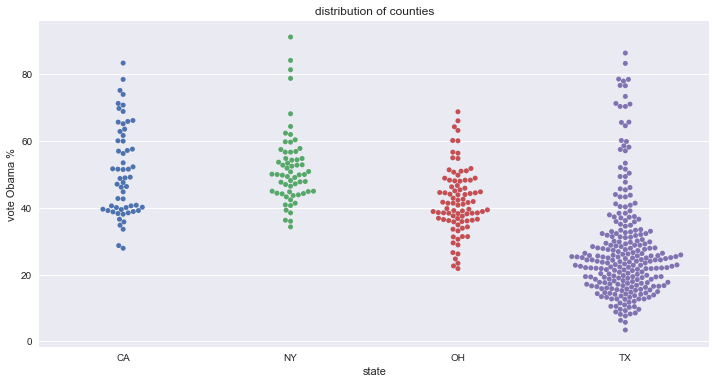
Empirical cumulative distribution function (ECDF)
def ecdf(data):
"""Compute ECDF for a one-dimensional array of measurements."""
n = len(data) # Number of data points
x = np.sort(data)
y = np.arange(1, n+1) / n
return x, y
# Compute ECDF for versicolor data
x_value, y_value = ecdf(virginica_petal_length)
# Generate plot
_ = plt.plot(x_value, y_value, marker='.', linestyle='none')
_ = plt.margins(0.02)
_ = plt.ylabel('ECDF')
_ = plt.xlabel('virginica petal length')
plt.show()
# 4.5 ~ 5.5cm : 전체의 50%
# 6.0cm 이상 : 전체의 20%
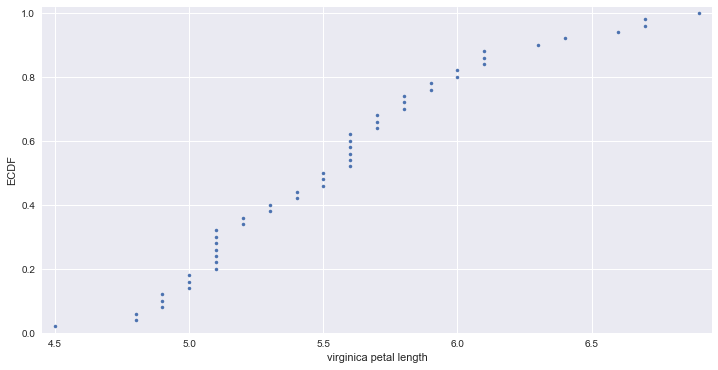
# Comparison of ECDFs
setosa_petal_length = iris.data[0:50,2]
versicolor_petal_length = iris.data[50:100,2]
virginica_petal_length = iris.data[100:150,2]
# Compute ECDFs
x_set, y_set = ecdf(setosa_petal_length)
x_vers, y_vers = ecdf(versicolor_petal_length)
x_virg, y_virg = ecdf(virginica_petal_length)
# Plot all ECDFs on the same plot
_ = plt.plot(x_set, y_set, marker='.', linestyle='none')
_ = plt.plot(x_vers, y_vers, marker='.', linestyle='none')
_ = plt.plot(x_virg, y_virg, marker='.', linestyle='none')
plt.margins(0.02)
# Annotate the plot
_ = plt.legend(('setosa', 'versicolor', 'virginica'), loc='lower right')
_ = plt.xlabel('petal length (cm)')
_ = plt.ylabel('ECDF')
plt.show()
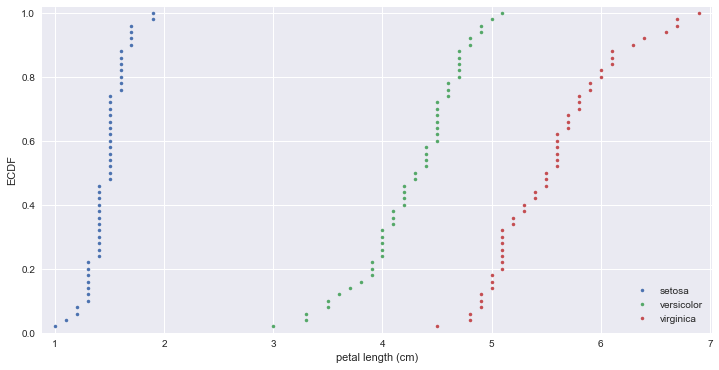
# 2012 미국 대선
vote_ny = df2012[df2012['state'] == 'NY']['Obama']
vote_oh = df2012[df2012['state'] == 'OH']['Obama']
vote_tx = df2012[df2012['state'] == 'TX']['Obama']
# Compute ECDFs
x_set, y_set = ecdf(vote_ny)
x_vers, y_vers = ecdf(vote_oh)
x_virg, y_virg = ecdf(vote_tx)
# Plot all ECDFs on the same plot
_ = plt.plot(x_set, y_set, marker='.', linestyle='none')
_ = plt.plot(x_vers, y_vers, marker='.', linestyle='none')
_ = plt.plot(x_virg, y_virg, marker='.', linestyle='none')
plt.margins(0.02)
# Annotate the plot
_ = plt.legend(('NY', 'OH', 'TX'), loc='lower right')
_ = plt.xlabel('vote Obama')
_ = plt.ylabel('ECDF')
plt.show()
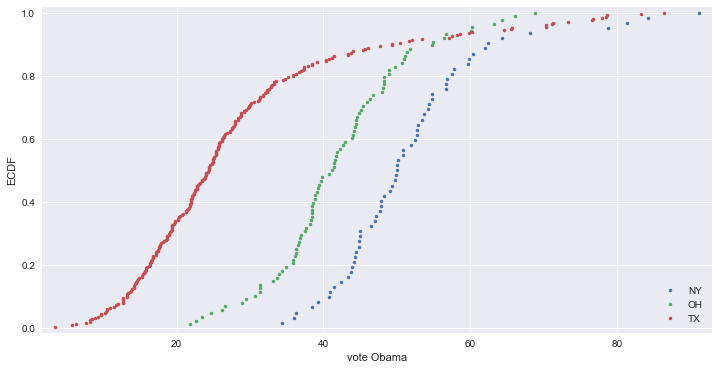
2. Quantitative exploratory data analysis
np.mean(vote_ny)
51.967741935483886
np.median(vote_ny)
50.0
Box plot
sb.boxplot(x='species', y='petal_length', data=df_iris)
_ = plt.xlabel('species')
_ = plt.ylabel('petal length (cm)')
plt.show()
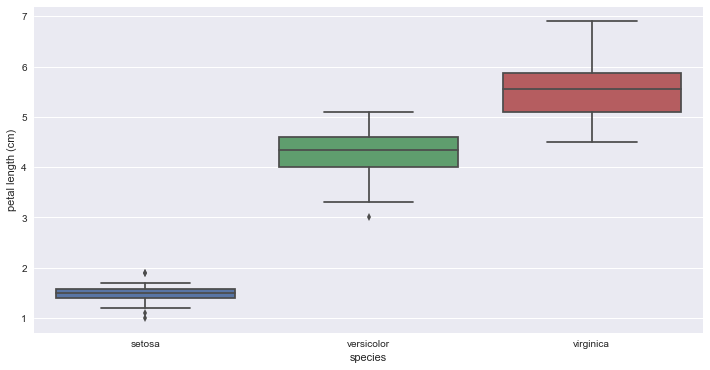
sb.boxplot(x='state', y='Obama', data=df2012)
_ = plt.xlabel('state')
_ = plt.ylabel('vote Obama %')
plt.show()
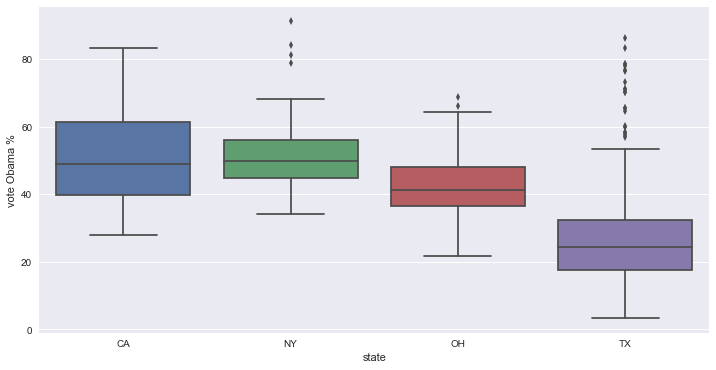
# 미투표자 비율에 대한 오바마 지지율
_ = plt.plot(df2012.turnout, df2012.Obama, marker='.', linestyle='none')
_ = plt.xlabel('% of not vote')
_ = plt.ylabel('percent of vote for Obama')
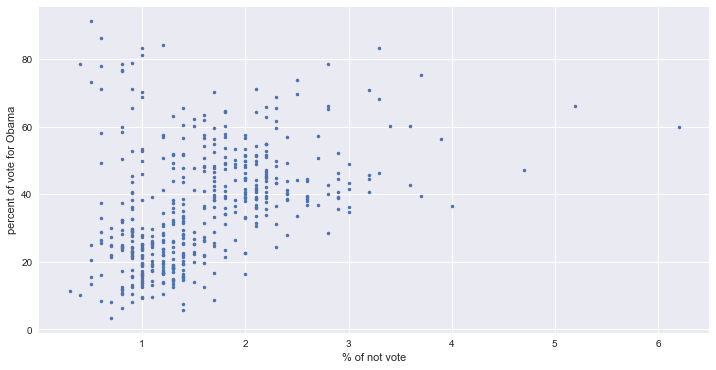
np.cov(df2012.turnout, df2012.Obama)
array([[ 0.56269093, 4.97298927],
[ 4.97298927, 299.29556718]])
def pearson_r(x, y):
"""Compute Pearson correlation coefficient between two arrays."""
corr_mat = np.corrcoef(x, y)
return corr_mat[0,1]
pearson_r(df2012.turnout, df2012.Obama)
0.38320610690704882
3. Probability - Discrete variables
Bernoulli trials - 1 or 0 (성공 / 실패)
def perform_bernoulli_trials(n, p):
"""Perform n Bernoulli trials with success probability p and return number of successes."""
n_success = 0
for i in range(n):
# Choose random number between 0 and 1
random_number = np.random.random()
# If less than p, it's a success so add one to n_success
if random_number < p:
n_success += 1
return n_success
# 100 명의 대출자 파산 확률 0.05. 1000 번 시뮬레이션
n_defaults = np.empty(1000)
for i in range(1000):
n_defaults[i] = perform_bernoulli_trials(100, 0.05)
_ = plt.hist(n_defaults, normed=True, edgecolor='black')
_ = plt.xlabel('number of defaults out of 100 loans')
_ = plt.ylabel('probability')
plt.show()
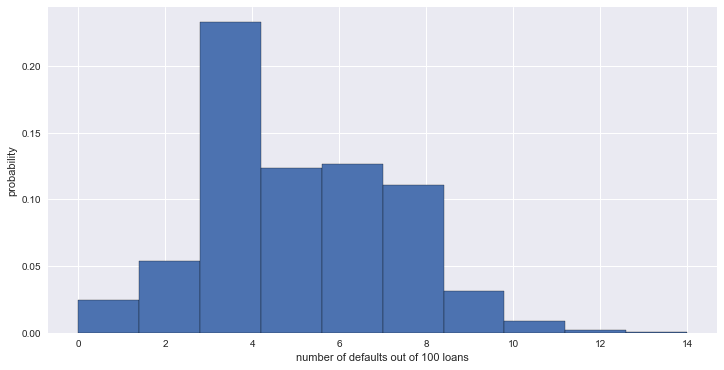
# 위 상황에 대한 ECDF
x, y = ecdf(n_defaults)
_ = plt.plot(x, y, marker='.', linestyle='none')
_ = plt.xlabel('number of defaults out of 100')
_ = plt.ylabel('CDF')
plt.show()
# 파산자가 10명 이상이 될 경우의 수 합계
n_lose_money = np.sum(n_defaults >= 10)
print('Probability of losing money =', n_lose_money / len(n_defaults))
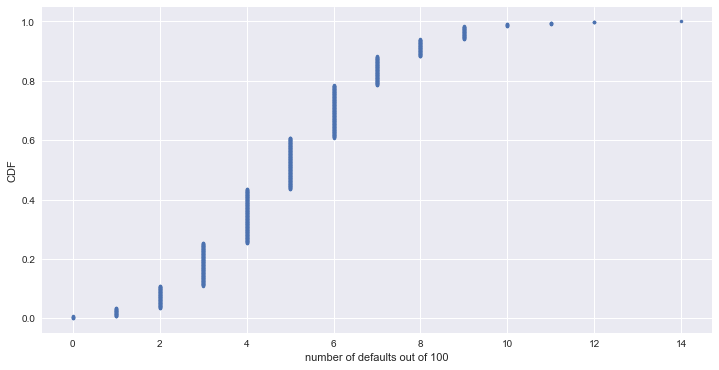
Probability of losing money = 0.016
Binomial distribution (이항 분포)
n_defaults = np.random.binomial(n=100, p=0.05, size=10000)
# CDF
x, y = ecdf(n_defaults)
_ = plt.plot(x, y, marker='.', linestyle='none')
_ = plt.xlabel('number of defaults out of 100 loans')
_ = plt.ylabel('CDF')
plt.show()
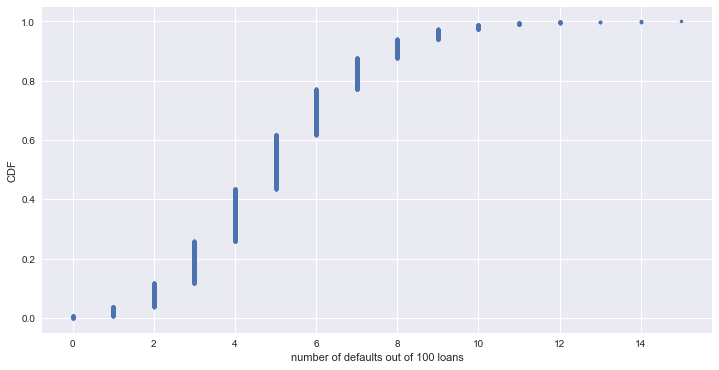
Probability mass function (PMF) - The set of probabilities of discrete outcomes
bins = np.arange(0, max(n_defaults) + 1.5) - 0.5
_ = plt.hist(n_defaults, normed=True, bins=bins, edgecolor='white')
_ = plt.xlabel('number of defaults out of 100 loans')
_ = plt.ylabel('PMF')
plt.margins(0.02)
plt.show()
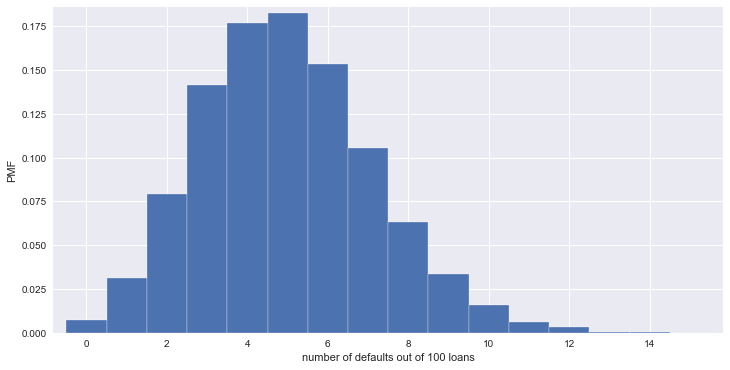
4. Probability - Continuous variables
# 1926년부터 경마 최고 기록
horse_race = np.array([ 148.51, 146.65, 148.52, 150.7, 150.42, 150.88, 151.57, 147.54, 149.65, 148.74, 147.86, 148.75, 147.5, 148.26, 149.71, 146.56, 151.19, 147.88, 149.16, 148.82, 148.96, 152.02, 146.82, 149.97, 146.13, 148.1, 147.2, 146., 149.8, 147., 147.2, 147.8, 148.2, 149., 149.8, 148.6, 146.8, 149.6, 149., 148.2, 149.2, 148., 150.4, 148.8, 147.2, 148.8, 149.6, 148.4, 148.4, 150.2, 148.8, 149.2, 149.2, 148.4, 150.2, 146.6, 149.8, 149., 150.8, 148.6, 150.2, 149., 148.6, 150.2, 148.2, 149.4, 150.8, 150.2, 152.2, 148.2, 149.2, 151., 149.6, 149.6, 149.4, 148.6, 150., 150.6, 149.2, 152.6, 152.8, 149.6, 151.6, 152.8, 153.2, 152.4, 152.2 ])
# 평균과 표준편차
mu = np.mean(horse_race)
sigma = np.std(horse_race)
horse_race
# 샘플링
samples = np.random.normal(mu, sigma, size=10000)
# 샘플링 데이터와 실제 데이터의 CDF
x_theor, y_theor = ecdf(samples)
x, y = ecdf(horse_race)
_ = plt.plot(x_theor, y_theor)
_ = plt.plot(x, y, marker='.', linestyle='none')
_ = plt.xlabel('Belmont winning time (sec.)')
_ = plt.ylabel('CDF')
plt.margins(0.02)
plt.show()
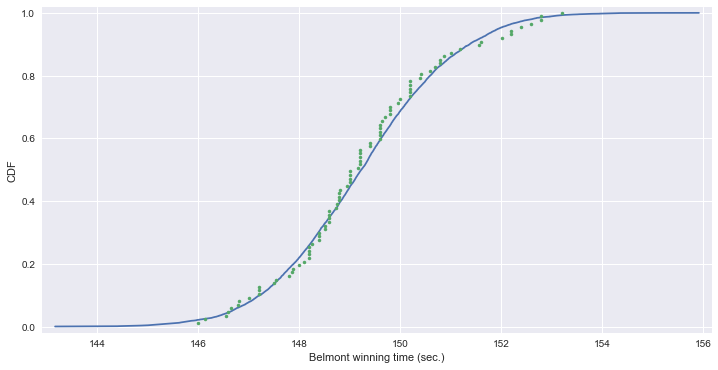
np.min(horse_race)
146.0
# 위 기록을 깰 확률을 시뮬레이션
samples = np.random.normal(mu, sigma, size=100000)
prob = np.sum(samples <= 146) / len(samples)
print('위 기록을 깰 확률:', prob)
위 기록을 깰 확률: 0.02097
Exponential distribution
# 미국 메이저리그 야구
# no-hitter : 투수가 한 경기에서 한번도 안타를 내주지 않음. 평균 764 경기 당 1회 발생.
# cycling hit : 타자가 한 경기에서 1루타, 2루타, 3루타, 홈런을 모두 기록. 평균 715 경기 당 1회 발생.
def successive_poisson(tau1, tau2, size=1):
# Draw samples out of first exponential distribution
t1 = np.random.exponential(tau1, size=size)
# Draw samples out of second exponential distribution
t2 = np.random.exponential(tau2, size=size)
return t1 + t2
# no-hitter와 cycling hit가 같이 나타나기 까지의 waiting game 수 시뮬레이션
waiting_times = successive_poisson(764, 715, size=100000)
waiting_times
array([ 1519.61768867, 2444.63870183, 913.80439492, ..., 726.54811866,
1397.66102354, 1111.50886872])
_ = plt.hist(waiting_times, bins=100, histtype='step', normed=True, edgecolor='blue')
_ = plt.xlabel('total waiting time (games)')
_ = plt.ylabel('PDF')
plt.show()
